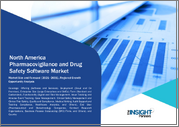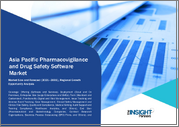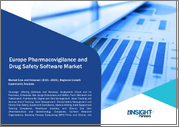
|
시장보고서
상품코드
1495977
세계의 약물감시 시장 - 예측(2024-2029년)Global Pharmacovigilance Market - Forecasts from 2024 to 2029 |
||||||
약물감시 시장은 예측 기간 동안 연평균 10.54%의 복합 성장률로 성장하여 2022년 57억 9,800만 달러에서 2029년 116억 8,800만 달러의 시장 규모에 도달할 것으로 예상됩니다.
약물감시는 의약품 안전이라고도 하며, 부작용 및 기타 의약품 및 백신과 관련된 문제를 감지, 평가, 이해 및 예방하는 과학 및 활동입니다. 모든 의약품과 백신은 사용이 허가되기 전에 임상시험을 통해 안전성과 유효성에 대한 엄격한 테스트를 거칩니다.
이 시장의 주요 촉진요인으로는 의약품 소비량 및 의약품 개발률 증가, 부작용 및 약독성 발생률 증가, 약물감시 서비스의 아웃소싱 추세 증가 등을 들 수 있습니다. 당뇨병, 고혈압, 심혈관 질환(CVD)과 같은 생활습관병의 유병률 증가는 좌식 생활, 운동 부족, 생활 패턴의 변화, 식습관의 변화 등으로 인해 의약품 소비가 증가하여 의약품 모니터링에 대한 수요가 높아져 시장 성장을 촉진하고 있습니다.
세계보건기구(WHO)에 따르면, 2019년 1,790만 명이 CVD로 사망했으며, 이는 전 세계 사망자의 32%를 차지합니다. 이 중 약 85%가 심장마비나 뇌졸중으로 인한 사망입니다. 전 세계적으로 약 12억 8,000만 명의 30-79세 인구가 고혈압을 앓고 있으며, 이들 중 대다수(2/3)는 중저소득 국가에 거주하고 있습니다. 또한, 당뇨병은 2019년에 150만 명의 사망을 초래할 것으로 예상되는 직접적인 원인이기도 합니다.
한편, 높은 데이터 보안 위험, 세계 규제 조화 부족, 부작용 수집을 위한 데이터 표준의 부재 등의 요인이 약물감시 시장에 도전이 될 것으로 예상됩니다.
시장 촉진요인:
- ADR의 증가가 약물감시 시장을 견인할 것으로 예상됩니다.
제약 부작용(ADR)의 증가로 인해 약물감시 시장은 성장할 것으로 예상됩니다. 이러한 성장 요인으로는 약물 사용 증가, 다양한 환자군, 엄격한 규제 요건, 의약품 안전에 대한 우려, 첨단 모니터링 기술, 임상시험의 세계화, 환자 중심 접근법, 신흥 시장에서의 시장 개척, 제약회사와 약물감시 서비스 제공업체 간의 협력, 시판 후 조사 활동 등이 있습니다. 시판 후 조사 활동 등을 들 수 있습니다. 전 세계 규제 당국은 의약품의 안전성을 보장하기 위해 강력한 약물감시 활동을 요구하고 있으며, 데이터 분석 및 인공지능과 같은 첨단 모니터링 기술은 ADR을 보다 효과적으로 감지하고 모니터링할 수 있는 능력을 향상시키고 있습니다.
미국 질병예방통제센터(CDC)에 따르면 입원 환자의 약 6.7%가 심각한 ADR을 경험하고 있으며, 사망률은 0.32%입니다. 이 수치가 사실이라고 가정하면 연간 약 221만 6,000건의 중증 ADR이 발생하며, 10만 6,000명 이상이 사망하는 것으로 추정할 수 있습니다. 이 통계가 사실이라고 가정하면 ADR은 폐질환, 당뇨병, 에이즈, 폐렴, 교통사고, 자동차 사고에 이어 4번째 사망원인입니다. 따라서 전 세계적으로 ADR의 확산이 증가함에 따라 약물감시 시장의 수요를 증가시킬 것으로 예상됩니다.
시장 억제요인:
- 부작용에 대한 일관성 없는 보고는 약물감시 시장을 저해할 수 있습니다.
약물감시는 의약품의 품질, 투약 오류, 약물 부작용과 관련된 것으로, 많은 환자 집단에 영향을 미쳐 의료시스템에 영향을 미칩니다. 부작용은 반드시 의료 서비스를 받는 동안에만 발생하는 것은 아닙니다. 투약 후 몇 시간 후에 발생할 수도 있습니다. 환자가 부작용을 보고하지 않는 것은 진단과 조사에 일관성이 없고 생명을 위협할 수 있습니다. 또한, 많은 사람들에게 장기간에 걸쳐 의약품을 투여하면 과학적 연구에서 이전에 발견되지 않은 부작용이 발생할 수 있습니다.
예를 들어, 2020년 Fresenius Kabi USA는 리도카인의 교차 오염으로 인해 덱스메데토미딘 염산염 0.9% 염화나트륨 주사액을 리콜했고, 2021년에는 니트로사민과 N-니트로소-발레니클린이 FDA의 잠정 허용 섭취 한계치보다 높았기 때문에 Pfizer는 Chantix 0.5mg과 1mg 정제의 모든 로트를 자발적으로 회수했습니다. N-니트로소-발레니클린의 장기 사용은 인간의 암 위험 증가와 관련이 있을 수 있지만, 이 약물을 사용하는 개인에게 즉각적인 위험은 없습니다. 위험은 없습니다.
북미가 크게 성장할 것으로 전망
약물감시 시장은 북미가 지배적인 시장으로 예상됩니다. 미국에서는 약물남용과 그에 따른 약물 부작용이 크게 증가하고 있습니다. 미국 보건복지부에 따르면 ADR은 병원 내 부작용의 3분의 1을 차지하는 것으로 추정되며, 매년 약 200만 명의 입원 환자에게 영향을 미치는 것으로 추정됩니다. 입원 일수는 1.7일에서 4.6일로 증가합니다.
외래에서 발생하는 ADE는 매년 약 350만 명의 의사 진료, 약 100만 명의 응급실 방문, 12만 5,000명 이상의 입원 환자 발생에 영향을 미칩니다. 미국 내 약물감시 체계는 사내 약물감시 업무가 위탁 연구기관에 위탁되어 높은 비용으로 인해 의료 시스템에서 수동적인 역할에서 능동적인 역할로 전환되고 있습니다.
주요 개발
- 2023년 3월 - LEO Pharma와 ICON은 혁신적인 임상시험과 신약에 대한 접근성을 제공함으로써 환자의 삶을 개선하기 위해 의료 피부과 분야의 임상시험 수행을 가속화하기 위해 제휴를 맺었습니다. 이번 제휴는 임상 개발의 효율적 확장성, 분산형 임상시험에 대한 공동 투자, ICON의 내부 보조 서비스, 범위와 규모의 경제 국가, 외부 데이터 등에 초점을 맞춘 하이브리드 소싱 모델 등을 포함합니다.
- 2023년 2월 - 임상 연구 기관인 파렉셀(Parexel)은 신약 개발 동향에 대한 세계 인사이트와 증거에 기반한 가이드를 바이오 제약 업계에 제공하기 위해 'New Medicines, Novel Insights' 시리즈를 시작했습니다. 첫 번째 보고서인 '희귀질환 치료제 개발의 진전'은 희귀질환 치료제 개발의 과제를 탐구하고 모범 사례를 소개합니다. 이 시리즈는 환자 중심 의약품 개발, 규제 당국 탐색, 적응증 시험, 환자 접근에 초점을 맞추고 있습니다.
- 2023년 1월 - 세계 분석 및 임상 연구 서비스 제공업체인 IQVIA는 중국 알리바바 클라우드와 첫 제휴를 맺었습니다. IQVIA는 중국 본토에서 Salesforce on Alibaba Cloud를 통해 호스팅된 솔루션을 제공함으로써 고객이 이 플랫폼을 활용하고 투자를 확대할 수 있도록 지원할 예정입니다. Customer Engagement 제품군 등 다양한 임상부터 상업용 제품군을 보유하고 있습니다. 이번 파트너십을 통해 IQVIA는 중국 현지화 솔루션 개발을 가속화하고 확장할 수 있게 됐습니다.
목차
제1장 소개
- 시장 개요
- 시장 정의
- 조사 범위
- 시장 세분화
- 통화
- 가정
- 기준 연도와 예측 연도 타임라인
- 이해관계자에 대한 주요 이점
제2장 조사 방법
- 조사 디자인
- 조사 과정
제3장 주요 요약
- 주요 조사 결과
제4장 시장 역학
- 시장 성장 촉진요인
- 시장 성장 억제요인
- Porter's Five Forces 분석
- 업계 밸류체인 분석
- 애널리스트의 견해
제5장 약물감시 세계 시장 : 임상시험 단계별
- 소개
- 전임상
- 단계 I
- 단계 II
- 단계 III
- 단계 IV
제6장 약물감시 세계 시장 : 서비스 프로바이더별
- 소개
- 계약 아웃소싱
- 사내
제7장 약물감시 세계 시장 : 최종사용자별
- 소개
- 의약품
- 바이오테크놀러지 기업
- 의료기기 제조업체
- 기타
제8장 약물감시 세계 시장 : 지역별
- 소개
- 북미
- 남미
- 유럽
- 중동 및 아프리카
- 아시아태평양
제9장 경쟁 환경과 분석
- 주요 기업과 전략 분석
- 시장 점유율 분석
- 합병, 인수, 합의와 협업
- 경쟁 대시보드
제10장 기업 개요
- Cognizant
- Sciformix(Covance)
- IQVIA
- APCER Life Sciences, Inc.
- Navitas Life Sciences
- BioClinica
- Accenture
- ArisGlobal
- Capgemini
- FMD K&L Inc.
The global pharmacovigilance market is expected to grow at a compound annual growth rate of 10.54% over the forecast period to reach a market size of US$11.688 billion in 2029 from US$5.798 billion in 2022.
Pharmacovigilance, also known as drug safety, is the science and activities involved with the detection, evaluation, comprehension, and prevention of adverse effects or other medicine or vaccine-related problems. All medicines and vaccines are submitted to rigorous testing for safety and efficacy in clinical trials before they are licenced for use.
The major driving factors of this market include rising drug consumption and drug development rates, rising rates of adverse drug reactions and drug toxicity, and an increasing tendency to outsource pharmacovigilance services. The rising prevalence of lifestyle-related diseases, such as diabetes, hypertension, and cardiovascular diseases (CVDs), as a result of sedentary lifestyles, a lack of physical activity, changing lifestyle patterns, and poor diets, leading to increased drug consumption, indicating a high demand for drug monitoring and fuelling the market growth.
According to the World Health Organization (WHO), 17.9 million people died from CVDs in 2019, accounting for 32% of all global deaths. About 85 % of these fatalities were caused by a heart attack or a stroke. Globally, an estimated 1.28 billion individuals aged 30-79 years have hypertension, with the majority(2/3rd) residing in low- and middle-income nations. Furthermore, diabetes is directly responsible for an anticipated 1.5 million fatalities in 2019.
On the other hand, factors such as high data security risk, a lack of global regulatory harmonization, and a lack of data standards for adverse event collection are expected to pose challenges to the global pharmacovigilance market.
Market Drivers:
- An increased prevalence of ADRs is anticipated to drive the global pharmacovigilance market.
The global pharmacovigilance market is expected to grow due to the rise in Adverse Drug Reactions (ADRs). Factors contributing to this growth include rising drug utilization, diverse patient populations, stringent regulatory requirements, drug safety concerns, advanced monitoring technologies, globalization of clinical trials, patient-centric approach, market expansion in developing regions, collaboration between pharmaceutical companies and pharmacovigilance service providers, and post-marketing surveillance activities. Regulatory authorities worldwide require robust pharmacovigilance activities to ensure drug safety, and advanced monitoring technologies like data analytics and artificial intelligence are enhancing the ability to detect and monitor ADRs more effectively.
According to the Centers for Disease Control and Prevention, about 6.7 percent of hospitalized patients experience a severe ADR, with a mortality rate of 0.32 percent. If these figures are assumed to be true, then there are about 2,216,000 severe ADRs in hospitalized patients per year, which results in over 106,000 deaths. If these statistics are assumed to be true, then ADRs are the fourth-largest cause of death, followed by pulmonary illness, diabetes, AIDS, pneumonia, accidents, and automobile accidents. Therefore, the rising global prevalence of ADRs will increase demand in the pharmacovigilance market.
Market Restraints:
- Inconsistent reporting of adverse reactions could hinder the global pharmacovigilance market
Pharmacovigilance is concerned with drug quality, dosage mistakes, and adverse drug responses that influence the healthcare system by impacting a large patient population. An adverse reaction does not necessarily occur during a visit to the healthcare center. It may occur several hours after the medication has been administered. Patients failing to report adverse reactions leads to inconsistency in diagnosis and research, which can be life-threatening. Furthermore, administering medicines for extended periods to a large population might result in adverse reactions that have not previously been detected in scientific studies.
For instance, Fresenius Kabi USA recalled Dexmedetomidine HCL in 0.9 % Sodium Chloride Injection in 2020 owing to lidocaine cross-contamination, which could have resulted in a potentially fatal allergic reaction. In 2021, due to the presence of nitrosamine and N-nitroso-varenicline at or above the FDA's interim permissible consumption limit, Pfizer voluntarily recalled all batches of its Chantix 0.5 mg and 1 mg Tablets to the patient (consumer/user) level. Long-term use of N-nitroso-varenicline may be linked to elevated cancer risk in humans, although there is no immediate danger to individuals using this drug.
North America region is expected to grow significantly.
The global pharmacovigilance market is expected to be dominated by the North American region. The number of drug abuse and associated adverse drug reactions in the United States has increased significantly. According to the U.S. Department of Health and Human Services, ADRs account for an estimated one-third of all hospital adverse events and affect about 2 million hospital stays each year in inpatient settings. Increasing hospital stays from 1.7 to 4.6 days.
ADEs in outpatient settings account for about 3.5 million doctor visits each year, as well as an estimated 1 million emergency room visits and over 125,000 hospitalizations. The pharmacovigilance system in the United States is transitioning from a passive to a proactive role in the healthcare system as a result of the high costs of in-house pharmacovigilance operations being outsourced to contract research organizations.
Key Developments:
- March 2023- LEO Pharma and ICON partnered to expedite clinical trial execution in medical dermatology, aiming to enhance patients' lives by providing access to innovative trials and new medicines. The partnership includes a hybrid sourcing model, focusing on lean scalability in clinical development, co-investment in decentralized trials, access to ICON's in-house ancillary services, economies of scope and scale, and external data. The partnership will support LEO Pharma's 2030 strategy, bringing innovative treatments to patients faster and supporting a more sustainable business.
- February 2023- Parexel, a clinical research organization, launched a series called New Medicines, Novel Insights, providing global insights into drug development trends and evidence-based guidance to the biopharmaceutical industry. The first report, Advancing Rare Disease Drug Development, explores challenges in rare disease drug development and shares best practices. The series emphasizes patient-focused drug development, regulatory navigation, adaptive trials, and patient access. It aims to make clinical development faster, more efficient, and patient-friendly.
- January 2023- IQVIA, a global provider of analytics and clinical research services, partnered with Alibaba Cloud in China for its first collaboration. The company provides solutions hosted in Mainland China using Salesforce on Alibaba Cloud, allowing customers to use or extend their investments on the platform. IQVIA offer rich clinical to commercial products, including its Orchestrated Customer Engagement suite, compliant with Chinese data residency regulations. The partnership enables IQVIA to accelerate and expand the development of solutions tailored to China's localized needs.
Market Segmentation:
By Clinical Trial Phase
- Preclinical
- Phase I
- Phase II
- Phase III
- Phase IV
By Service Provider
- Contract Outsourcing
- In-house
By End-User
- Pharmaceuticals
- Biotechnology Companies
- Medical Device Manufacturers
- Others
By Geography
- North America
- USA
- Canada
- Mexico
- South America
- Brazil
- Argentina
- Others
- Europe
- Germany
- France
- United Kingdom
- Italy
- Spain
- Others
- Middle East and Africa
- Saudi Arabia
- UAE
- South Africa
- Others
- Asia Pacific
- China
- India
- Japan
- South Korea
- Taiwan
- Thailand
- Indonesia
- Others
TABLE OF CONTENTS
1. INTRODUCTION
- 1.1. Market Overview
- 1.2. Market Definition
- 1.3. Scope of the Study
- 1.4. Market Segmentation
- 1.5. Currency
- 1.6. Assumptions
- 1.7. Base and Forecast Years Timeline
- 1.8. Key Benefits to the Stakeholder
2. RESEARCH METHODOLOGY
- 2.1. Research Design
- 2.2. Research Processes
3. EXECUTIVE SUMMARY
- 3.1. Key Findings
4. MARKET DYNAMICS
- 4.1. Market Drivers
- 4.2. Market Restraints
- 4.3. Porter's Five Forces Analysis
- 4.3.1. Bargaining Power of Suppliers
- 4.3.2. Bargaining Power of Buyers
- 4.3.3. Threat of New Entrants
- 4.3.4. Threat of Substitutes
- 4.3.5. Competitive Rivalry in the Industry
- 4.4. Industry Value Chain Analysis
- 4.5. Analyst View
5. GLOBAL PHARMACOVIGILANCE MARKET BY CLINICAL TRIAL PHASE
- 5.1. Introduction
- 5.2. Preclinical
- 5.2.1. Market Opportunities and Trends
- 5.2.2. Growth Prospects
- 5.2.3. Geographic Lucrativeness
- 5.3. Phase I
- 5.3.1. Market Opportunities and Trends
- 5.3.2. Growth Prospects
- 5.3.3. Geographic Lucrativeness
- 5.4. Phase II
- 5.4.1. Market Opportunities and Trends
- 5.4.2. Growth Prospects
- 5.4.3. Geographic Lucrativeness
- 5.5. Phase III
- 5.5.1. Market Opportunities and Trends
- 5.5.2. Growth Prospects
- 5.5.3. Geographic Lucrativeness
- 5.6. Phase IV
- 5.6.1. Market Opportunities and Trends
- 5.6.2. Growth Prospects
- 5.6.3. Geographic Lucrativeness
6. GLOBAL PHARMACOVIGILANCE MARKET BY SERVICE PROVIDER
- 6.1. Introduction
- 6.2. Contract Outsourcing
- 6.2.1. Market Opportunities and Trends
- 6.2.2. Growth Prospects
- 6.2.3. Geographic Lucrativeness
- 6.3. In-house
- 6.3.1. Market Opportunities and Trends
- 6.3.2. Growth Prospects
- 6.3.3. Geographic Lucrativeness
7. GLOBAL PHARMACOVIGILANCE MARKET BY END-USER
- 7.1. Introduction
- 7.2. Pharmaceuticals
- 7.2.1. Market Opportunities and Trends
- 7.2.2. Growth Prospects
- 7.2.3. Geographic Lucrativeness
- 7.3. Biotechnology Companies
- 7.3.1. Market Opportunities and Trends
- 7.3.2. Growth Prospects
- 7.3.3. Geographic Lucrativeness
- 7.4. Medical Device Manufacturers
- 7.4.1. Market Opportunities and Trends
- 7.4.2. Growth Prospects
- 7.4.3. Geographic Lucrativeness
- 7.5. Others
- 7.5.1. Market Opportunities and Trends
- 7.5.2. Growth Prospects
- 7.5.3. Geographic Lucrativeness
8. GLOBAL PHARMACOVIGILANCE MARKET BY GEOGRAPHY
- 8.1. Introduction
- 8.2. North America
- 8.2.1. By Clinical Trial Phase
- 8.2.2. By Service Provider
- 8.2.3. By End-User
- 8.2.4. By Country
- 8.2.4.1. USA
- 8.2.4.1.1. Market Opportunities and Trends
- 8.2.4.1.2. Growth Prospects
- 8.2.4.2. Canada
- 8.2.4.2.1. Market Opportunities and Trends
- 8.2.4.2.2. Growth Prospects
- 8.2.4.3. Mexico
- 8.2.4.3.1. Market Opportunities and Trends
- 8.2.4.3.2. Growth Prospects
- 8.2.4.1. USA
- 8.3. South America
- 8.3.1. By Clinical Trial Phase
- 8.3.2. By Service Provider
- 8.3.3. By End-User
- 8.3.4. By Country
- 8.3.4.1. Brazil
- 8.3.4.1.1. Market Opportunities and Trends
- 8.3.4.1.2. Growth Prospects
- 8.3.4.2. Argentina
- 8.3.4.2.1. Market Opportunities and Trends
- 8.3.4.2.2. Growth Prospects
- 8.3.4.3. Others
- 8.3.4.3.1. Market Opportunities and Trends
- 8.3.4.3.2. Growth Prospects
- 8.3.4.1. Brazil
- 8.4. Europe
- 8.4.1. By Clinical Trial Phase
- 8.4.2. By Service Provider
- 8.4.3. By End-User
- 8.4.4. By Country
- 8.4.4.1. Germany
- 8.4.4.1.1. Market Opportunities and Trends
- 8.4.4.1.2. Growth Prospects
- 8.4.4.2. France
- 8.4.4.2.1. Market Opportunities and Trends
- 8.4.4.2.2. Growth Prospects
- 8.4.4.3. United Kingdom
- 8.4.4.3.1. Market Opportunities and Trends
- 8.4.4.3.2. Growth Prospects
- 8.4.4.4. Italy
- 8.4.4.4.1. Market Opportunities and Trends
- 8.4.4.4.2. Growth Prospects
- 8.4.4.5. Spain
- 8.4.4.5.1. Market Opportunities and Trends
- 8.4.4.5.2. Growth Prospects
- 8.4.4.6. Others
- 8.4.4.6.1. Market Opportunities and Trends
- 8.4.4.6.2. Growth Prospects
- 8.4.4.1. Germany
- 8.5. Middle East and Africa
- 8.5.1. By Clinical Trial Phase
- 8.5.2. By Service Provider
- 8.5.3. By End-User
- 8.5.4. By Country
- 8.5.4.1. Saudi Arabia
- 8.5.4.1.1. Market Opportunities and Trends
- 8.5.4.1.2. Growth Prospects
- 8.5.4.2. UAE
- 8.5.4.2.1. Market Opportunities and Trends
- 8.5.4.2.2. Growth Prospects
- 8.5.4.3. South Africa
- 8.5.4.3.1. Market Opportunities and Trends
- 8.5.4.3.2. Growth Prospects
- 8.5.4.4. Others
- 8.5.4.4.1. Market Opportunities and Trends
- 8.5.4.4.2. Growth Prospects
- 8.5.4.1. Saudi Arabia
- 8.6. Asia Pacific
- 8.6.1. By Clinical Trial Phase
- 8.6.2. By Service Provider
- 8.6.3. By End-User
- 8.6.4. By Country
- 8.6.4.1. China
- 8.6.4.1.1. Market Opportunities and Trends
- 8.6.4.1.2. Growth Prospects
- 8.6.4.2. India
- 8.6.4.2.1. Market Opportunities and Trends
- 8.6.4.2.2. Growth Prospects
- 8.6.4.3. Japan
- 8.6.4.3.1. Market Opportunities and Trends
- 8.6.4.3.2. Growth Prospects
- 8.6.4.4. South Korea
- 8.6.4.4.1. Market Opportunities and Trends
- 8.6.4.4.2. Growth Prospects
- 8.6.4.5. Taiwan
- 8.6.4.5.1. Market Opportunities and Trends
- 8.6.4.5.2. Growth Prospects
- 8.6.4.6. Thailand
- 8.6.4.6.1. Market Opportunities and Trends
- 8.6.4.6.2. Growth Prospects
- 8.6.4.7. Indonesia
- 8.6.4.7.1. Market Opportunities and Trends
- 8.6.4.7.2. Growth Prospects
- 8.6.4.8. Others
- 8.6.4.8.1. Market Opportunities and Trends
- 8.6.4.8.2. Growth Prospects
- 8.6.4.1. China
9. COMPETITIVE ENVIRONMENT AND ANALYSIS
- 9.1. Major Players and Strategy Analysis
- 9.2. Market Share Analysis
- 9.3. Mergers, Acquisitions, Agreements, and Collaborations
- 9.4. Competitive Dashboard
10. COMPANY PROFILES
- 10.1. Cognizant
- 10.2. Sciformix (Covance)
- 10.3. IQVIA
- 10.4. APCER Life Sciences, Inc.
- 10.5. Navitas Life Sciences
- 10.6. BioClinica
- 10.7. Accenture
- 10.8. ArisGlobal
- 10.9. Capgemini
- 10.10. FMD K&L Inc.



















